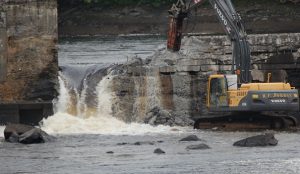DSRRN – Regional Restoration Efforts
Click here for Restoration Efforts in the Western U.S. (Northeast Pacific species distribution)
Great Works Dam Removal on the Penobscot River
 The Great Works Dam is located on the Penobscot River in Old Town and Bradley, Maine, and is owned by the Penobscot River Restoration Trust. Removal work on the dam began in early June 2012. Contractor R.F. Jordan and Sons of Ellsworth removed approximately 10,000 cubic yards of material from the river including concrete, timber and rockfill. http://www.facebook.com/PenobscotRiver
The Great Works Dam is located on the Penobscot River in Old Town and Bradley, Maine, and is owned by the Penobscot River Restoration Trust. Removal work on the dam began in early June 2012. Contractor R.F. Jordan and Sons of Ellsworth removed approximately 10,000 cubic yards of material from the river including concrete, timber and rockfill. http://www.facebook.com/PenobscotRiver
National Fish Passage Program Restoration Films in Vermont and Maine
Restoring R oads, Streams and Fish Through Improved Culverts and Flooding in Vermont
oads, Streams and Fish Through Improved Culverts and Flooding in Vermont
http://www.youtube.com/watch?v=5sS-owj1_kc
Multi-agency coordination leads to successful dam removal, Simkins Dam, Patapsco River, Maryland
http://gallery.usgs.gov/videos/494
Faith Fitzpatrick (U.S. Geological Survey) and Serena McClain (American Rivers, Director, River Restoration) discuss the history of how this dam removal became possible. Allen Gellis (USGS Maryland Water Science Center) discusses the importance of monitoring sediment transport related to dam removal. Matt Collins (National Oceanic and Atmospheric Administration) describes NOAA’s Fish Passage Program and how NOAA works to fund implementation and monitoring of dam removals. Graham Boardman (McCormick Taylor) discusses geomorphic monitoring and mapping, as well as sediment releases associated with dam removal.
Video on Large Woody Debris Placement on the Narraguagus River, Maine, with Project SHARE and USFWS
http://home.salmonhabitat.org/narraguagas-lwd-additions-a-video/
As a pilot project to see if this method of tree placement will hold large trees in place throughout the year, Project SHARE, DMR, and USFWS are trying to create some complexity within the river system. Large woody debris placement increases ecological diversity and creates small waterfalls, thereby increasing dissolved oxygen and cold water.
Bunker Pond Dam, Lamprey River, Epping, NH
The removal of the Bunker Pond Dam, located on the “Wild and Scenic” Lamprey River in Epping, NH, was removed in August 2011. The project took the State of New Hampshire’s Department of Environmental Services Dam Construction Crew 6 days to remove. The project was partially funded by the American Rivers/NOAA Community-based Restoration Program. Removal of the dam has opened up 27 miles of river, including tributaries in the upper Lamprey River watershed. With completion of the fishway at the Wiswall Dam anticipated in spring 2012, 70 miles of main stem and tributaries on the Lamprey River will be open to diadromous fish passage. For more information:
http://www.americanrivers.org/newsroom/blog/bgraber-20110818-northeast-dam-removals-river-life-back.html
 Annapolis River in Nova Scotia
Annapolis River in Nova Scotia
Clean Annapolis River Project, a watershed group in Nova Scotia’s Annapolis Valley, has recently completed one of the first planned dam removals in the province. The Clementsport dam was removed in early September 2011 from the lower Moose River to provide migratory fish passage. For more information: http://www.annapolisriver.ca/projects_mooseriver.php or contact Andy Sharpe.
Return to DSRRN Home
